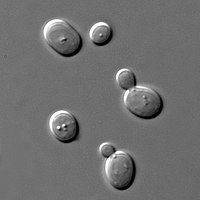
Photo from wikipedia
In this work, the production of xylitol from a hemicellulosic hydrolysate of exhausted olive pomace (EOP), a residue originated in the olive oil production process by Candida boidinii, was assessed.… Click to show full abstract
In this work, the production of xylitol from a hemicellulosic hydrolysate of exhausted olive pomace (EOP), a residue originated in the olive oil production process by Candida boidinii, was assessed. The hydrolysate was obtained by dilute acid pretreatment of EOP at 170 °C and 2% H2SO4 (w/v). A previous detoxification step of the hydrolysate was necessary, and its treatment with activated charcoal and ion-exchange resin was evaluated. Prior to fermentation of the hydrolysate, fermentation tests in synthetic media were performed to determine the maximum xylitol yield and productivity that could be obtained if inhibitory compounds were not present in the medium. In addition, the glucose existing in the media exerted a negative influence on xylitol production. A maximum xylitol yield of 0.52 g/g could be achieved in absence of inhibitor compounds. Fermentation of the hemicellulosic hydrolysate from EOP after detoxification with ion-exchange resin resulted in a xylitol yield of 0.43 g/g.
Journal Title: Applied Sciences
Year Published: 2020
Link to full text (if available)
Share on Social Media: Sign Up to like & get
recommendations!